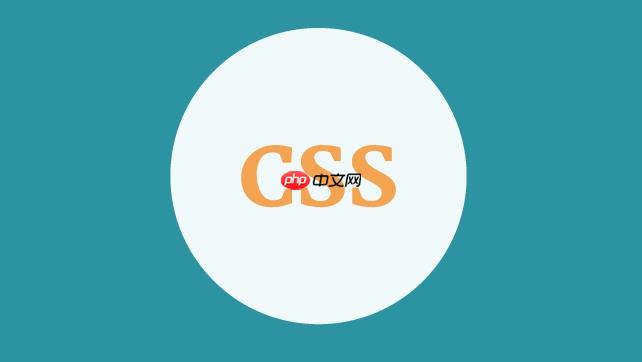最直接画虚线用border-style: dashed,但需精确控制时推荐border-image或SVG。1. border-style: dashed生成默认虚线,快捷但不可控;2. border-image结合repeating-linear-gradient可自定义虚线长度、间距;3. SVG通过stroke-dasharray实现复杂图案,支持矢量缩放,适合高精度设计需求。

css中画虚线最直接的方法是使用
border-style: dashed;
,它能快速生成一个默认的虚线边框。但如果想要更精细地控制虚线的长度、间距、甚至不同的虚线模式,比如点划线或者更复杂的图案,我们就需要借助
border-image
或者将SVG作为背景图来实现高度自定义。在我看来,虽然基础的
dashed
很方便,但在追求设计细节和跨浏览器一致性时,高级技巧才是真正的利器。
解决方案
要画虚线,最基础的办法就是利用CSS的
border-style
属性。但如果想玩得更花哨,更灵活,就得请出
border-image
或者直接用SVG来做背景。
1. 基础虚线:
border-style: dashed;
这是最简单、最直接的方式。你只需要给元素的
border-style
设置为
dashed
就行。
立即学习“前端免费学习笔记(深入)”;
.dashed-box { border: 2px dashed #333; padding: 20px; width: 200px; height: 100px; text-align: center; }
这种方法非常快,但它的缺点也很明显:你无法控制虚线的长度和间距,浏览器会根据自己的算法来渲染,不同浏览器之间可能会有细微的差异。
2. 高级定制:
border-image
border-image
是一个非常强大的属性,它可以让你用一张图片(或者渐变)作为边框。通过巧妙地构造这张“图片”,我们就能实现各种自定义的虚线效果。
核心思路是创建一个包含虚线图案的渐变图像,然后用
border-image-slice
和
border-image-repeat
来控制它的展示。
.custom-dashed-border-image { border: 5px solid transparent; /* 边框宽度必须有,且颜色不重要,因为会被图片覆盖 */ border-image: linear-gradient(to right, #333 50%, transparent 50%) 1 / 5px 0 / 0 stretch; border-image-slice: 1; /* 关键:不切片,整个图片作为边框 */ border-image-repeat: repeat; /* 让图案重复 */ /* 更详细的 border-image 简写属性解释: border-image: <'border-image-source'> || <'border-image-slice'> [ / <'border-image-width'>? [ / <'border-image-outset'> ]? ]? || <'border-image-repeat'>? 这里是: linear-gradient(to right, #333 50%, transparent 50%) (source) 1 (slice) / 5px 0 (width: top/bottom 5px, left/right 0) / 0 (outset) stretch (repeat: here it's repeat, not stretch) 实际上,对于虚线,我们通常需要 repeat。 */ border-image: linear-gradient(to right, #333 50%, transparent 50%) 1 repeat; /* 更简洁的写法 */ border-image-slice: 1; /* 这行是关键,确保整个渐变作为边框 */ border-image-width: 5px; /* 边框的宽度 */ border-image-repeat: repeat; /* 让渐变重复 */ padding: 20px; width: 200px; height: 100px; text-align: center; } /* 更好的 border-image 虚线示例,控制虚线和间距 */ .custom-dashed-gradient { border: 5px solid transparent; /* 边框宽度 */ border-image: repeating-linear-gradient( 90deg, #333 0 10px, /* 虚线长度 10px */ transparent 10px 20px /* 间距 10px */ ) 1 stretch; /* slice 1, repeat stretch (等同于 repeat) */ /* 或者这样写更清晰: */ /* border-image-source: repeating-linear-gradient(90deg, #333 0 10px, transparent 10px 20px); */ /* border-image-slice: 1; */ /* border-image-width: 5px; */ /* border-image-repeat: stretch; */ /* 这里用 stretch 会根据边框拉伸,repeat 更适合虚线 */ /* 针对虚线,我个人更倾向于使用 repeat */ border-image: repeating-linear-gradient( 90deg, #333 0 10px, transparent 10px 20px ) 1 repeat; padding: 20px; width: 200px; height: 100px; text-align: center; margin-top: 20px; }
3. 终极自由:SVG背景图
如果说
border-image
是高级定制,那SVG就是艺术创作了。你可以用SVG画出任何你想要的虚线图案,然后把它作为元素的背景图。这种方式的优势在于,你可以精确控制每一个点的形状、大小、颜色,而且SVG是矢量图,无论放大缩小都不会失真。
.svg-dashed-border { /* 创建一个简单的SVG虚线图案 */ background-image: url("data:image/svg+xml,%3Csvg width='10' height='2' xmlns='http://www.w3.org/2000/svg'%3E%3Crect width='5' height='2' fill='%23333'/%3E%3C/svg%3E"); background-repeat: repeat-x; /* 水平重复 */ background-position: left top, left bottom; /* 放置在顶部和底部 */ background-size: 100% 2px; /* 控制虚线的高度 */ /* 垂直虚线需要额外的背景图或伪元素 */ padding: 20px; width: 200px; height: 100px; text-align: center; margin-top: 20px; position: relative; /* 用于伪元素定位 */ } /* 如果需要四条边都是虚线,且样式统一,可以使用伪元素 */ .svg-dashed-border::before, .svg-dashed-border::after { content: ''; position: absolute; left: 0; right: 0; height: 2px; background-image: url("data:image/svg+xml,%3Csvg width='10' height='2' xmlns='http://www.w3.org/2000/svg'%3E%3Crect width='5' height='2' fill='%23333'/%3E%3C/svg%3E"); background-repeat: repeat-x; } .svg-dashed-border::before { top: 0; } .svg-dashed-border::after { bottom: 0; } .svg-dashed-border .vertical-line-left, .svg-dashed-border .vertical-line-right { position: absolute; top: 0; bottom: 0; width: 2px; background-image: url("data:image/svg+xml,%3Csvg width='2' height='10' xmlns='http://www.w3.org/2000/svg'%3E%3Crect width='2' height='5' fill='%23333'/%3E%3C/svg%3E"); background-repeat: repeat-y; } .svg-dashed-border .vertical-line-left { left: 0; } .svg-dashed-border .vertical-line-right { right: 0; }
这种SVG方案,如果只是简单的四边虚线,用
border-image
可能更简洁。但如果虚线图案本身很复杂,或者需要动态变化,SVG就显得非常灵活了。
为什么简单的
border-style: dashed;
border-style: dashed;
有时不够用?
说实话,
border-style: dashed;
在很多情况下是足够了,它实现起来最快。但作为一个有点追求的设计师或者开发者,你很快就会发现它的局限性。
首先,它对虚线的“点”和“间距”的控制几乎是零。浏览器有自己的一套算法来渲染
dashed
边框,通常是根据边框宽度自动调整点和间距的比例。这意味着你无法指定“我想要一个5px长的虚线,然后是3px的间距”。这种不确定性在像素完美的ui设计中简直是噩梦。有时候,你会发现虚线在不同的浏览器、不同的缩放级别下,甚至在同一个浏览器但元素尺寸略有不同时,都会呈现出不一样的效果。这真的让人头疼,尤其是当你试图让设计稿和实际效果完全一致的时候。
再者,
dashed
的样式相对单一。它只能是简单的矩形点状虚线。如果你的设计要求是圆形虚线、三角形虚线,或者更复杂的点划线模式,那
dashed
就彻底歇菜了。它无法满足这些创意性的需求。在我看来,这种“一刀切”的方案,在如今高度定制化的网页设计趋势下,显得有些力不从心了。当设计系统对虚线有严格的规范时,
border-style: dashed;
几乎是无法满足要求的。
如何利用
border-image
border-image
实现高度自定义的虚线效果?
border-image
这玩意儿,初看起来有点复杂,但一旦你掌握了它的精髓,你会发现它简直是虚线定制的瑞士军刀。它允许你用一张图片(或者说,更常用的是CSS渐变)来作为元素的边框。关键在于怎么构造这张“图片”和怎么“切片”及“重复”它。
我们通常会用
repeating-linear-gradient
来生成虚线图案。比如,如果你想要一个10px长的实线,然后接10px的透明间距,你可以这样写:
.border-image-example { border: 5px solid transparent; /* 必须有边框宽度,但颜色不重要 */ border-image: repeating-linear-gradient( 90deg, /* 渐变方向,90deg表示水平方向 */ #f00 0 10px, /* 从0到10px是红色实线 */ transparent 10px 20px /* 从10px到20px是透明,形成间距 */ ) 1 repeat; /* slice 1表示不切片,整个渐变作为边框;repeat表示重复 */ width: 250px; height: 150px; padding: 20px; box-sizing: border-box; text-align: center; line-height: 100px; font-family: sans-serif; color: #333; margin: 20px auto; }
这里面的
repeating-linear-gradient(90deg, #f00 0 10px, transparent 10px 20px)
,它会生成一个每20px循环一次的图案:前10px是红色,后10px是透明。
90deg
确保这个图案是水平方向的。
然后是
border-image
的简写属性:
-
repeating-linear-gradient(...)
:这是
border-image-source
,也就是我们的虚线图案来源。
-
1
:这是
border-image-slice
。
1
意味着我们不进行任何切片,整个源图像都用于边框。对于虚线,我们通常就是想让整个图案重复,所以
1
是最常见的选择。
-
repeat
:这是
border-image-repeat
。它告诉浏览器如何填充边框区域。
repeat
会平铺我们的渐变图案,直到填满整个边框。你也可以用
round
(调整图案大小以完整显示)或
stretch
(拉伸图案以填满),但对于虚线,
repeat
通常是最佳选择,因为它能保持虚线和间距的固定比例。
通过调整
repeating-linear-gradient
中的颜色、长度和透明度,你几乎可以创造出任何你想要的虚线模式。比如,想要点划线,可以这样:
.dot-dash-border-image { border: 4px solid transparent; border-image: repeating-linear-gradient( 90deg, #007bff 0 4px, /* 点 */ transparent 4px 8px, /* 点间距 */ #007bff 8px 18px, /* 划 */ transparent 18px 22px /* 划间距 */ ) 1 repeat; width: 250px; height: 150px; padding: 20px; box-sizing: border-box; text-align: center; line-height: 100px; font-family: sans-serif; color: #333; margin: 20px auto; }
这种方法非常灵活,而且浏览器兼容性也相当不错(除了IE9及以下)。我觉得,掌握了
border-image
,你对CSS边框的控制力就上了一个台阶。
SVG与CSS结合,打造无限可能的虚线样式
当
border-image
也无法满足你天马行空的创意时,SVG就该登场了。SVG(可缩放矢量图形)允许你用XML语法定义二维图形,这意味着你可以画出任何复杂的路径、形状,并对其进行精确的样式控制。我们可以把这些SVG图形直接嵌入到CSS中作为背景图片,或者用
mask
等属性来实现更高级的效果。
最常见的做法是创建一个包含虚线图案的SVG,然后将其编码成Data URI,作为
background-image
的值。SVG的
stroke-dasharray
属性是实现虚线的核心。它定义了描边(stroke)的虚线模式:一个数字序列,表示实线长度和间隙长度交替出现。
比如,一个简单的5px实线,5px间距的虚线:
<svg width="10" height="2" xmlns="http://www.w3.org/2000/svg"> <line x1="0" y1="1" x2="10" y2="1" stroke="#333" stroke-width="2" stroke-dasharray="5,5" /> </svg>
这段SVG代码定义了一个宽10px、高2px的画布,并在其中画了一条从(0,1)到(10,1)的直线。
stroke="#333"
设置颜色,
stroke-width="2"
设置粗细,最关键的是
stroke-dasharray="5,5"
,它让这条线变成了5px实线、5px间隙的虚线。
为了在CSS中使用,我们需要把这段SVG编码成Data URI。有很多在线工具可以做这个,或者手动编码(例如空格变
%20
,
#
变
%23
等)。
.svg-custom-dashed { position: relative; width: 250px; height: 150px; padding: 20px; box-sizing: border-box; text-align: center; line-height: 100px; font-family: sans-serif; color: #333; margin: 20px auto; /* 清除默认边框,使用伪元素模拟边框 */ border: none; } /* 使用伪元素创建顶部和底部的虚线 */ .svg-custom-dashed::before, .svg-custom-dashed::after { content: ''; position: absolute; left: 0; right: 0; height: 2px; /* 虚线的高度 */ background-image: url("data:image/svg+xml,%3Csvg width='10' height='2' xmlns='http://www.w3.org/2000/svg'%3E%3Cline x1='0' y1='1' x2='10' y2='1' stroke='%23333' stroke-width='2' stroke-dasharray='5%2C5'/%3E%3C/svg%3E"); background-repeat: repeat-x; /* 水平重复 */ } .svg-custom-dashed::before { top: 0; } .svg-custom-dashed::after { bottom: 0; } /* 使用伪元素创建左侧和右侧的虚线 */ .svg-custom-dashed .vertical-line-left, .svg-custom-dashed .vertical-line-right { content: ''; /* 这里不能用 content:'' 因为已经是一个 div 了,所以需要一个真实的元素 */ position: absolute; top: 0; bottom: 0; width: 2px; /* 虚线的宽度 */ background-image: url("data:image/svg+xml,%3Csvg width='2' height='10' xmlns='http://www.w3.org/2000/svg'%3E%3Cline x1='1' y1='0' x2='1' y2='10' stroke='%23333' stroke-width='2' stroke-dasharray='5%2C5'/%3E%3C/svg%3E"); background-repeat: repeat-y; /* 垂直重复 */ } .svg-custom-dashed .vertical-line-left { left: 0; } .svg-custom-dashed .vertical-line-right { right: 0; }
这种方法提供了无与伦比的控制力。你可以创建任何形状的“点”(比如圆形、星形),任何复杂的重复模式。因为SVG是矢量图,所以缩放不会有任何失真,完美适应高DPI屏幕。缺点是,对于简单的虚线,代码量可能会略大,而且管理Data URI字符串也稍显繁琐。不过,对于那些对设计细节有极致追求的项目,SVG绝对是值得投入的。它不仅仅是画虚线,更像是给你的UI元素披上了一层定制的艺术外衣。
虚线在实际项目中的常见应用场景与注意事项
虚线在网页设计中扮演着很多角色,不仅仅是装饰。
常见应用场景:
- 分隔线: 最常见的用途,比如在内容块之间、菜单项之间,用一条细虚线来暗示内容的逻辑分离,但又不想用实线显得太生硬。
- 表单输入框: 有些设计会给输入框一个虚线边框,尤其是在用户输入时,或者表示这是一个可选的输入字段。
- 拖拽区域指示: 当你需要用户拖拽文件或元素到特定区域时,一个动态的虚线边框(通常在hover或drag-over时出现)能清晰地指示可交互区域。这能提供很好的视觉反馈。
- 加载动画或占位符: 有时候,虚线可以用来模拟内容的轮廓,作为骨架屏的一部分,或者在内容加载时显示一个临时的边框。
- 图表或数据可视化: 在某些图表中,虚线可能代表预测值、平均值或者次要的数据系列,以区分主要数据。
注意事项:
- 可访问性: 虚线通常比实线“弱”,所以在用于传达重要信息(比如错误状态)时,要确保其对比度足够高,或者辅以其他视觉提示(如颜色、图标或文本)。单纯的细虚线可能对视力不佳的用户不太友好。
- 性能: 过于复杂的
border-image
(尤其是包含大量颜色变化的渐变)或者非常大的SVG Data URI可能会对页面渲染性能产生轻微影响。虽然通常不是大问题,但在移动端或低性能设备上仍需留意。
- 浏览器兼容性:
border-style: dashed;
兼容性最好。
border-image
在现代浏览器中支持良好,但旧版IE(IE9及以下)不支持。SVG作为背景图的方案兼容性也很好,但Data URI的长度限制在某些老旧环境可能存在。确保为不支持的浏览器提供优雅降级方案,比如回退到
border-style: dashed;
或者实线。
- **响应式设计


评论(已关闭)
评论已关闭